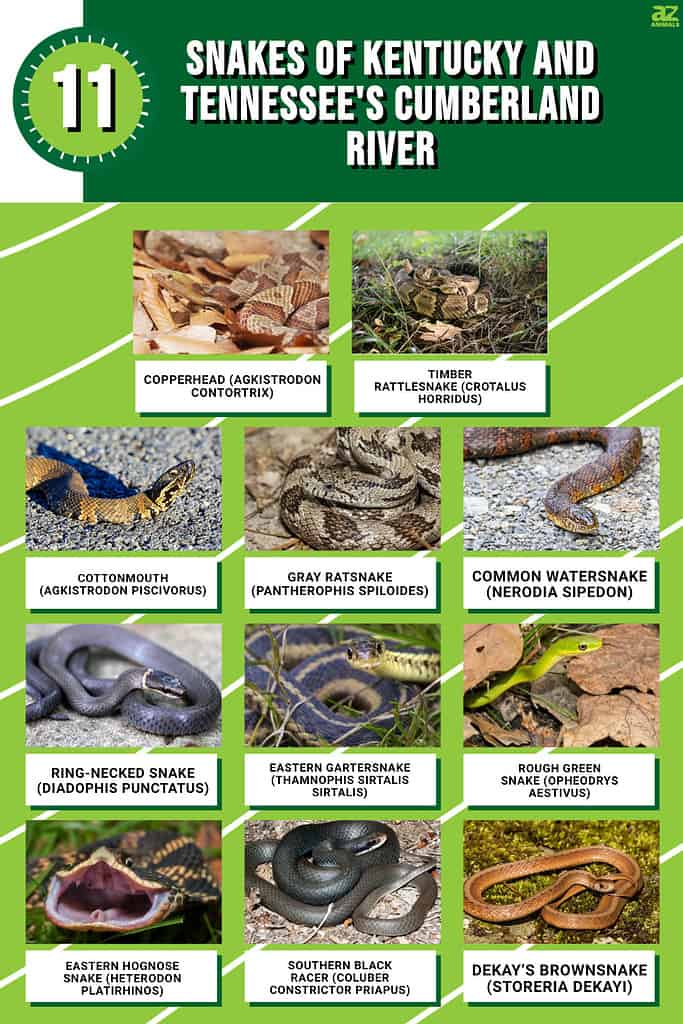
Flowing through parts of Kentucky and Tennessee, the Cumberland River’s 688 miles are home to thousands of plants and animals. It begins where three separate forks converge in Baxter, Kentucky. From there, it meanders west and south, dipping into north-central Tennessee, then turns north, back into Kentucky, where it joins the Ohio River near Paducah, Kentucky. Nature lovers of all types enjoy hiking, boating, and fishing around its banks and waters.
While mostly rural, there are a couple of large cities located along the river’s shores, including Nashville and Clarksville in Tennessee. These cities take advantage of the gorgeous landscapes the river creates, and they’ve incorporated parks and riverwalks into their design. However, that’s not all you’ll find along the Cumberland River! Over a dozen snake species also call it home. Let’s discover the most common snakes of Kentucky and Tennessee’s Cumberland River.
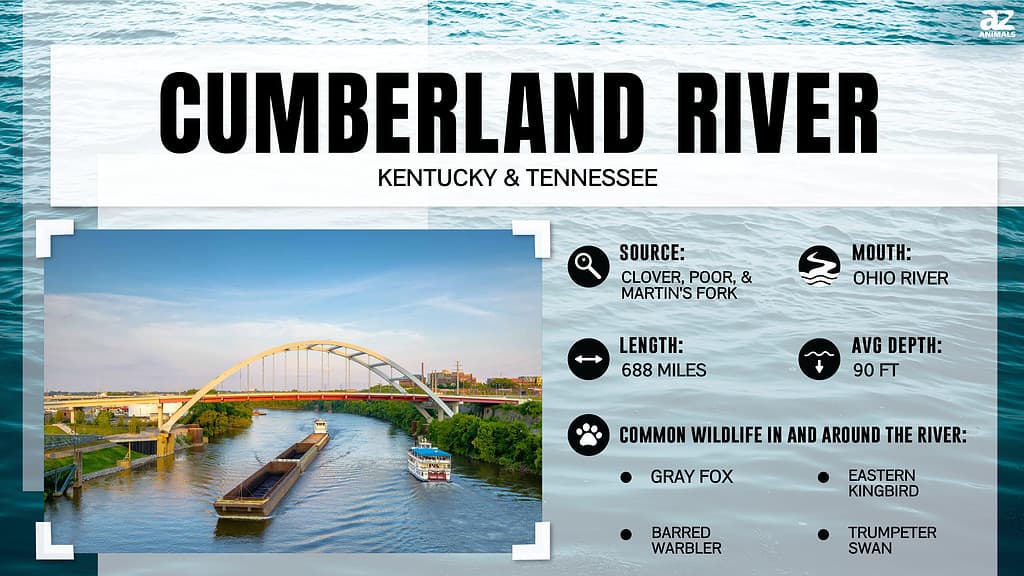
When are Snakes Most Active Around the Cumberland River?
As cold-blooded animals, snakes are dependent on the heat that the sun provides. So, when the average nighttime temperatures drop below about 50 degrees Fahrenheit, they start looking for a safe little cubby for the winter. Then, once it warms up again, they emerge to find a mate, feed, and either give birth or lay eggs.
Some species tend toward daylight activity while others tend toward nighttime, but most adjust their habits according to the current temperatures.
What Snakes Live Along the Cumberland River?
Nearly all the snakes of Kentucky and Tennessee’s Cumberland River are harmless. In fact, you’ll only find three venomous snakes, and one doesn’t venture east of Nashville. Venomous snakes near the Cumberland River in Tennessee and Kentucky are all pit vipers, making identification easier.
Let’s start with the dangerous snakes. Because when you know how those look, you’ll know that everything else is harmless! If you’re bitten by a venomous snake, it is always a medical emergency. Seeking immediate medical attention is key to surviving the experience without lasting damage.
Copperhead (Agkistrodon contortrix)
It’s not the biggest, nor is it the most dangerous. However, it is one of the most common snakes of Kentucky and Tennessee’s Cumberland River.
Copperheads have copper-colored heads with matching irises and vertical pupils. As pit vipers, they also have chunky-for-their-size heads and bodies with skinny necks. In Kentucky and Tennessee, they typically have a gray to pinkish-brown base color with darker hourglass-shaped saddle markings.
These snakes don’t usually get any longer than three feet, and juveniles have a bright yellow or green tail tip. Their favorite foods include various arthropods and small vertebrates — copperheads sometimes climb trees after cicadas!
According to the sightings reported on iNaturalist.org, copperhead sightings are more common along the western end of the Cumberland River. However, they can be found from one end of it to another.
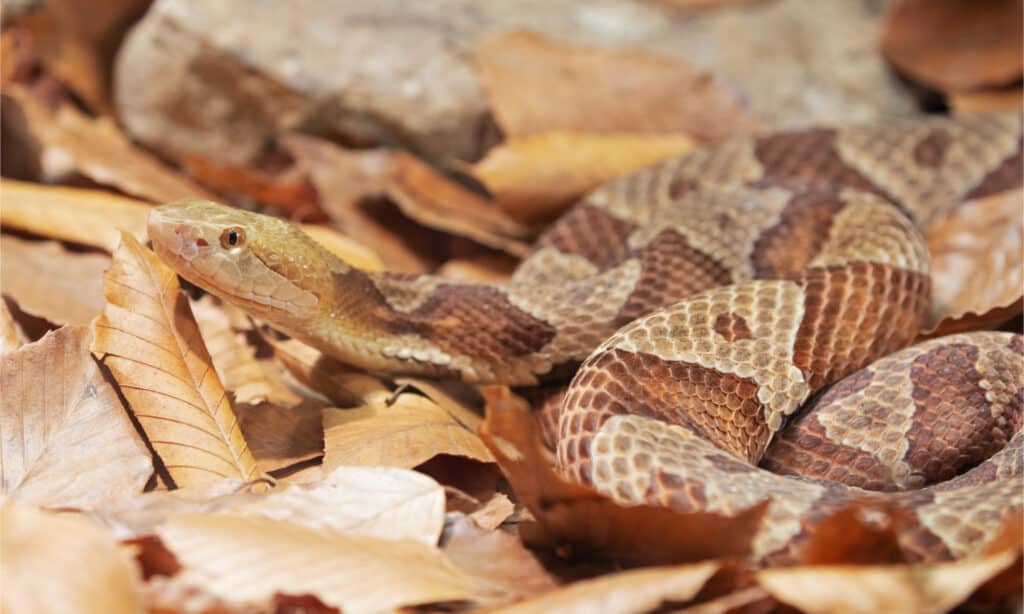
Copperheads hide in leaf litter, where they’re almost invisible
©DnDavis/Shutterstock.com
Timber Rattlesnake (Crotalus horridus)
These big rattlesnakes are capable of injecting vast amounts of venom. They’re known to have four different types of venom. However, in Tennessee and Kentucky, the most likely suspect is the hemotoxic variety. Fortunately, they’re decidedly not aggressive and prefer to pretend that you don’t see them!
Expert in the art of camouflage, a timber rattlesnake’s pattern is perfect for the job. Its base color varies and can be gray, yellowish brown, or even dark brown with black V or M-shaped saddle markings. Their markings fade towards the tail and become rich, inky black before ending in a rattle.
Timber rattlesnakes eat a variety of prey. They enjoy munching on prey like small rodents, birds, lizards, smaller snakes, and even arthropods. While they’re not known for climbing or swimming, they occasionally partake in both activities when in search of food or a mate.
While their range covers most of the Cumberland River’s track, timber rattlesnakes are more commonly spotted in different pockets along the river — they’re more common in the western half.
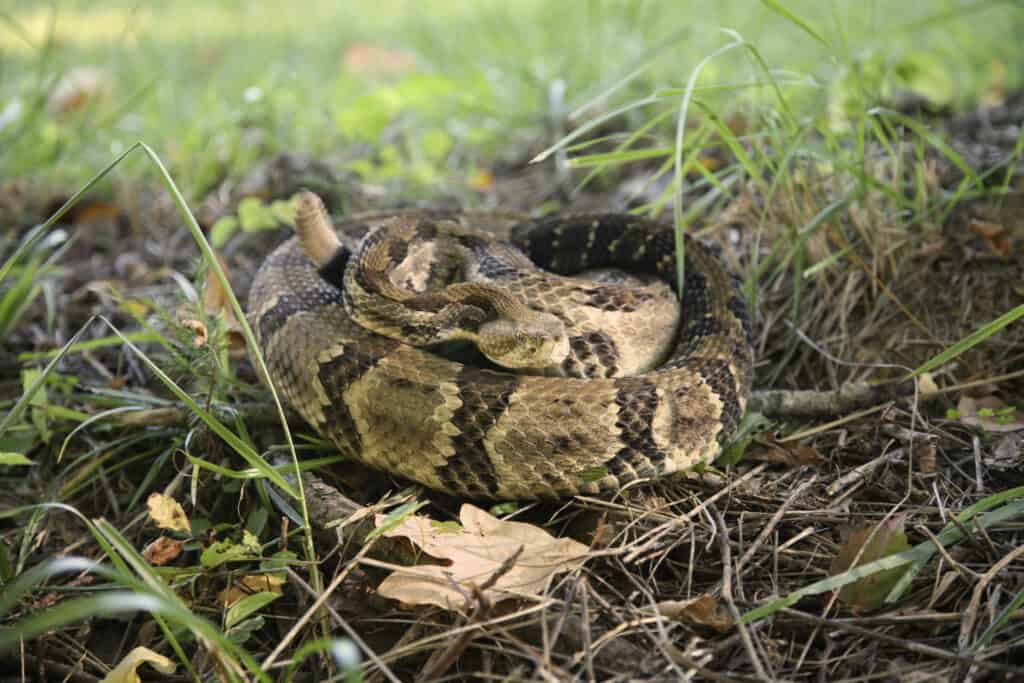
Timber Rattlesnakes are extremely venomous, but they are not typically aggressive.
©iStock.com/NajaShots
Cottonmouth (Agkistrodon piscivorus) — West of Nashville
Although semiaquatic, cottonmouths aren’t common in and around the Cumberland River. If you see one, it’s more likely to be west of Nashville than east.
Cottonmouths are medium-sized pit vipers that aren’t as aggressive as the rumors say. Most average 26 to 35 inches, but 71 inches is possible. They have keeled scales and a jagged-edged pattern that looks similar to copperheads when young; as they mature, their color darkens to a nearly solid dark brown or blackish brown.
Like other pit vipers, cottonmouths have big chunky heads to accommodate their rather large venom glands. They also have a dark head stripe that starts behind the eye and extends backward from there.
If you get too close to one, the snake will throw its mouth open to show off its stark-white mouth as a warning. While they don’t move very fast on land, they have one of the quickest strikes in nature, so your best option is to back away and give it time to move along.
Cottonmouths are happy to eat just about anything, including mammals, birds, fish, eggs, amphibians, insects, smaller snakes, turtles, and even alligators. However, their diet is typically focused on fish and amphibians.
A bite from one of these is a medical emergency, and cottonmouth venom can cause extensive tissue damage, although deaths are rare.
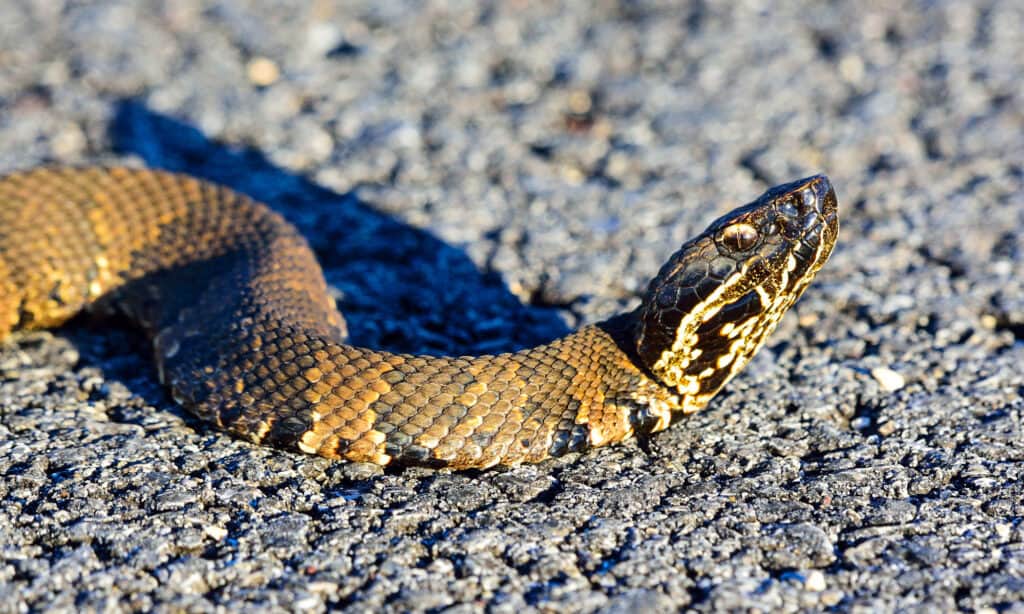
Cottonmouths are venomous snakes.
©Ad Konings/Shutterstock.com
Gray Ratsnake (Pantherophis spiloides)
Harmless rat snakes are among the most adventurous snakes you’ll find near the Cumberland River. They’re excellent climbers and often scale vertical walls, trees, and cliff faces.
Unlike other rat snakes in the Pantherophis genus, gray ratsnakes keep most of the pattern as they age. Their gray base color and darker dorsal splotches make for a beautiful combination with glossy scales.
Gray ratsnakes are long and thin but not as skinny as garter snakes. These snakes can measure up to six feet long and make a career out of getting into odd places. They eat various prey like small rodents and birds but also eat eggs and anything they can get their mouth around.
These snakes are common throughout the Cumberland River Basin and perhaps the most commonly sighted snake in the region — partly because they’re diurnal and do the majority of their hunting during the day.

Gray ratsnakes retain most of their juvenile pattern as adults
©Jay Ondreicka/Shutterstock.com
Common Watersnake (Nerodia sipedon)
Nearly as common as the gray rat snake, common watersnakes thrive in and along the Cumberland River. These nonvenomous snakes are perfectly at home in the shallows along the shoreline, where they hunt fish and amphibians.
Common watersnakes are heavier-bodied than most nonvenomous snakes in the region. That, combined with their often dark adult coloration, explains why they’re mistaken for cottonmouths. Young snakes are usually brighter with a light brown, gray, or tan base color and darker cross bands. These snakes grow up to four and a half feet long, and most average three and a half.
They’re common along the Cumberland River’s length but don’t stray far from the water. You’re likely to find them sunning along the water’s edge, where they rest between hunting for their prey — mostly fish and amphibians.
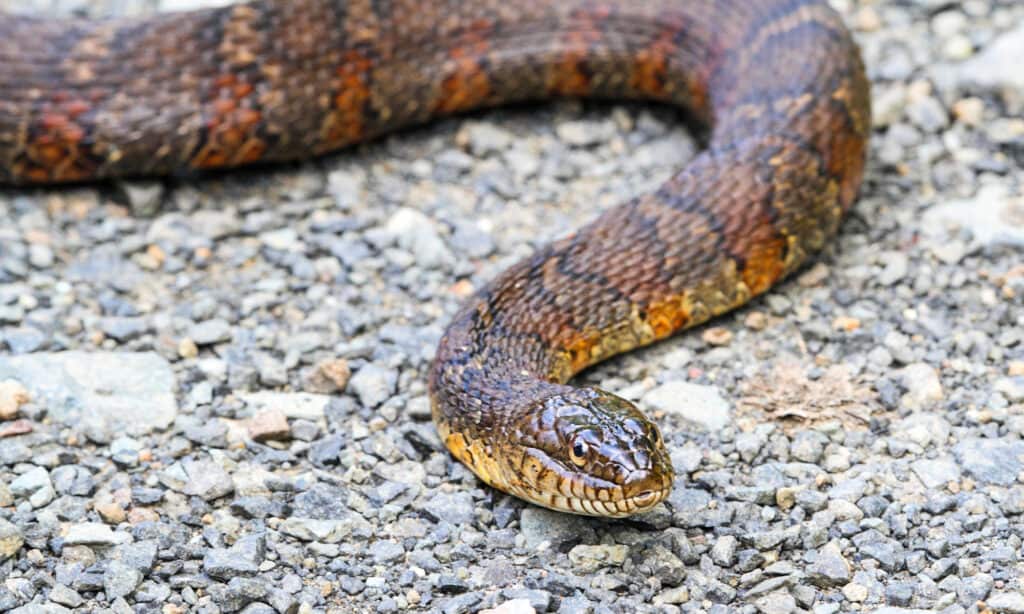
Northern watersnakes are one of the most widespread watersnakes in North America.
©Steve Byland/Shutterstock.com
Ring-Necked Snake (Diadophis punctatus)
These tiny, harmless snakes mostly eat snails, worms, slugs, and other small, soft-bodied creatures. Ring-necked snakes are pretty common along the edge of the Cumberland River but aren’t big swimmers. You may find them hiding under rotten logs, leaf litter, and debris, where they hunt their prey.
Ring-necked snakes are nocturnal and secretive. The only time you’ll see one is if you flip over a log or rock. These snakes usually measure between 10 and 15 inches long, and have a solid colored black, gray, or brown back with a light-colored neck ring and matching belly color. Their heads are usually a little darker than the rest of the body.
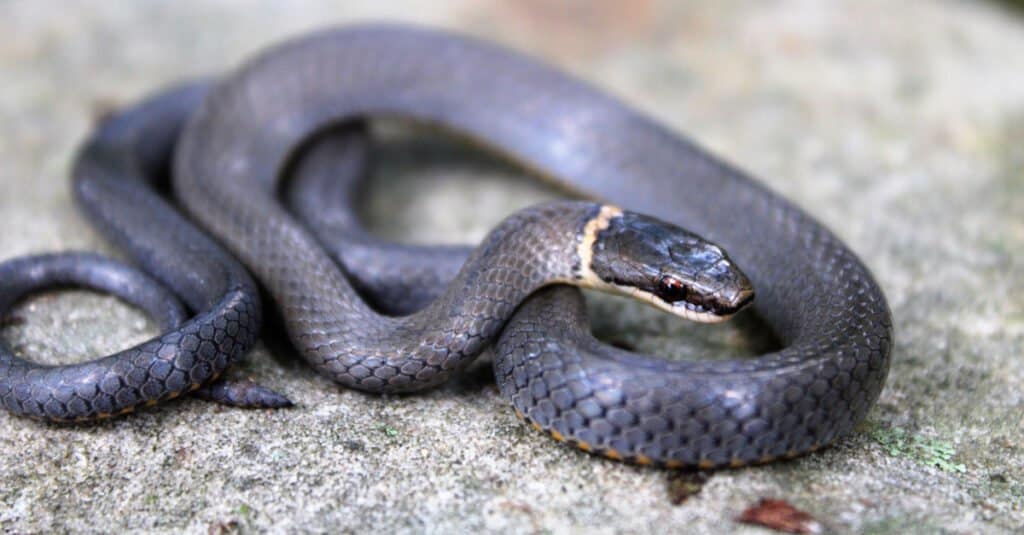
Ring-necked snakes (
Diadophis punctatus) are nocturnal.
©Tucker Heptinstall/Shutterstock.com
Eastern Gartersnake (Thamnophis sirtalis sirtalis)
Garter snakes are semiaquatic and spend almost as much time in or around the water as a watersnake. However, they’re not true water snakes because that title goes to the snakes of the Nerodia genus, like the common watersnake.
Eastern garter snakes are sometimes away from water. However, they’re almost always close to a permanent water source because their main foods are small fish and amphibians. They’ll eat other things like small insects and even rodents in a pinch but prefer to stick with fish and frogs.
These snakes can grow up to four feet long but typically stay a little smaller than that. Eastern garter snakes around the Cumberland River are usually dark-colored. They have three light stripes that begin behind their heads and run all the way to their tails. It makes sense that they’re one of the most common snakes found along the river because they’re diurnal — and one of the most widespread snakes in North America.
Although eastern garter snakes are harmless to people, but are mildly venomous. However, their venom only affects their food and helps subdue the animal before they swallow it. If you try to pick one up, make sure you have soap and water handy — they’re more likely to release the worst-smelling musk as they try to escape.
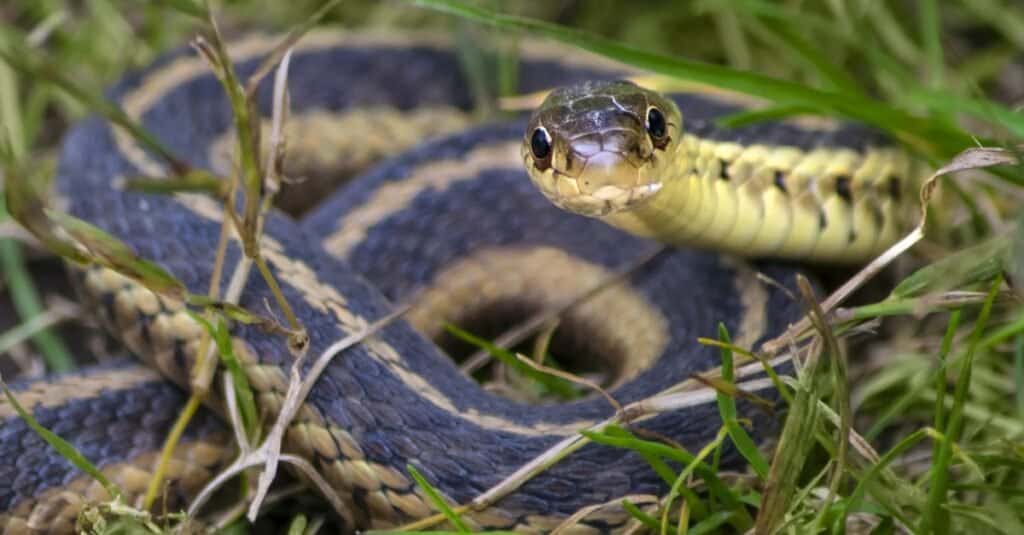
Common eastern Garter snake, coiled in the grass. Garter snakes are harmless to people, but have mildly venomous saliva.
©K Quinn Ferris/Shutterstock.com
Rough Green Snake (Opheodrys aestivus)
Chances are, if you find a bright green snake with a lighter-colored belly along the Cumberland River in Tennessee or Kentucky, it’s a rough green snake. While they’re more common in the West, you can find them all along the river. These thin snakes are native to the southeastern United States and spend most of their time in the trees.
Rough green snakes can grow to nearly four feet long and have big, friendly eyes. They mainly eat small arthropods and other insects, but sometimes eat tree frogs too. These snakes are very docile and seldom bite — but they’re nonvenomous, so even if they did bite, you’d be fine.

The skin of a rough green snake makes it easy for it to climb trees.
©iStock.com/BobMcLeanLLC
Eastern Hognose Snake (Heterodon platirhinos)
A snake-lover favorite! Eastern hognose snakes are relatively small and only grow to about 30 inches. They have lighter base colors that can be orange, tan, gray, or brown, with dark blotches over the top. Their common name comes from their upturned nasal scales that eastern hognose snakes use to dig in the loose soil that they prefer. These snakes often have darker-colored bellies, but not always.
While they’re cute little snakes, they’re really known for their dramatic defensive displays! When threatened, hognose snakes often play dead — rolling over onto their backs, displaying the darker belly, and coiling up. They even leave their mouth hanging wide open and tongues hanging out!
You’re more likely to find an eastern hognose along the east half of the Cumberland River, but they’re possible along most of it. Eastern hognoses are mildly venomous but aren’t dangerous to people. Besides — they don’t bite often.
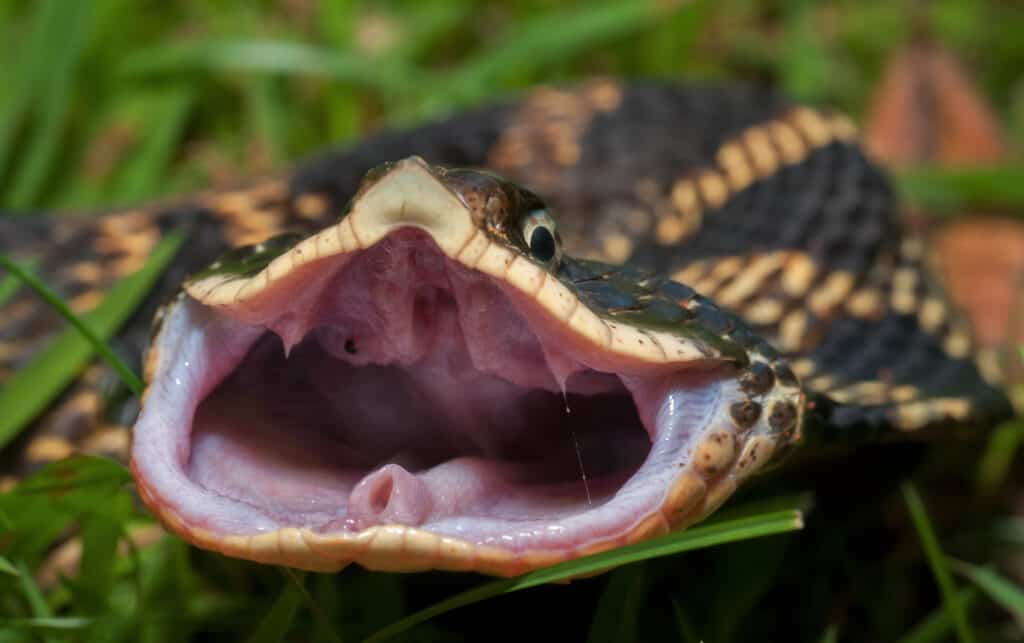
Eastern Hognose snake posing flattened out and gaping with mouth open and rear fangs exposed
©Mike Wilhelm/Shutterstock.com
Southern Black Racer (Coluber constrictor priapus)
Nonvenomous racers of some type are nearly everywhere in the United States. Around the Cumberland River, you’re most likely to encounter southern black racers. These snakes do their part to keep the rodent population in check and eat a few other snakes in the process — including venomous ones.
Fast-moving snakes, the southern black racers are well-named! They can travel at up to four miles per hour. If that doesn’t seem like much, remember that racers don’t have legs and yet still cruise faster than most people walk.
Young racers are often mistaken for rat snakes because their patterns are similar. As adults, racers are usually solid-colored with light-colored bellies and, depending on where they live, can be green, red, blue, brown, or black. In the Cumberland River, you’ll typically find are usually black with lighter-colored bellies.
Southern black racers hunt by day, have round pupils, and can grow to five feet long, but most average around four feet. If cornered, they fight viciously, bite repeatedly, and will leave a few marks but little damage.
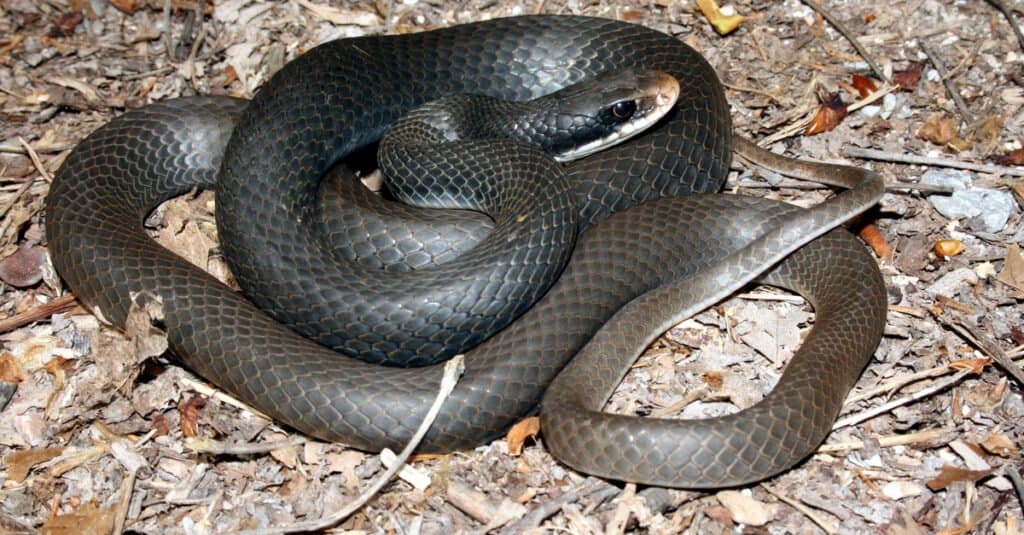
The diet of the southern black racer consists of Mice, birds, baby rodents, birds eggs, and tree frogs.
©Psychotic Nature/Shutterstock.com
Dekay’s Brownsnake (Storeria dekayi)
As common as they are plain-looking, Dekay’s brownsnakes are small and nocturnal. It’s also very secretive, so the fact that they’re found so often gives us an idea of how many live around the Cumberland River.
They’re slug and worm eaters that spend most of their time under logs, leaf litter, and debris — where their preferred prey hides.
Dekay’s brownsnakes are nonvenomous and only grow to about 12 inches long. The record length is only 19 inches! This snake almost never bites and only tries to wiggle away from you. Their brown base color with a lighter dorsal line and sometimes black flecks along the spine help them blend in with the moist debris where they hide. Dekay’s brownsnakes sometimes have darker markings behind their heads, and their dorsal line leads sometimes leads people to misidentify them as garter snakes. While they’re distant cousins, they’re not in the same genus.
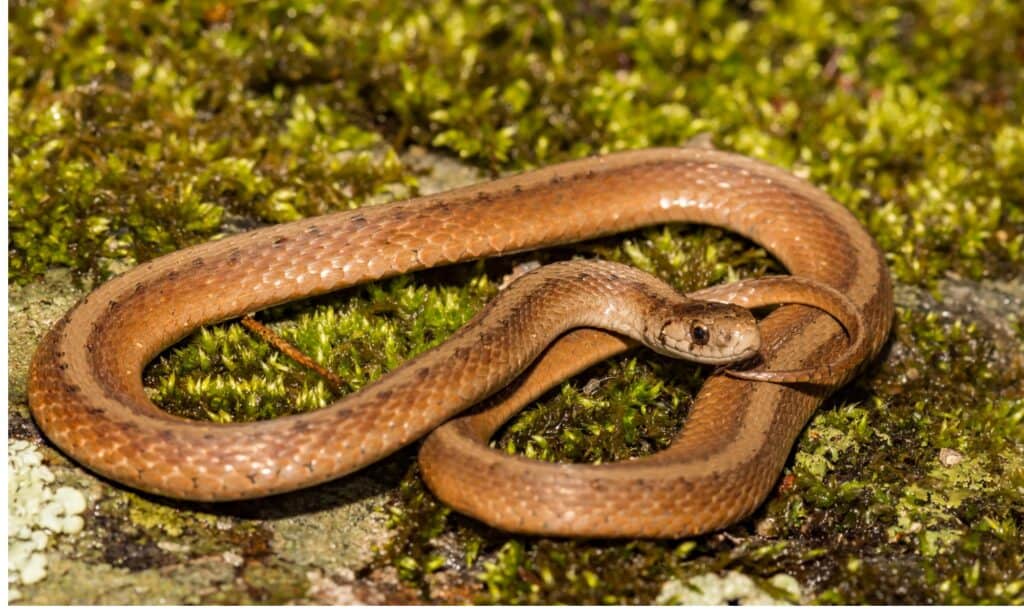
Northern brown snakes are the type species for Storeria dekayi.
©iStock.com/JasonOndreicka
Other Snakes Found Near the Cumberland River
These aren’t the only 11 snakes you’ll find in or around the Cumberland River in Kentucky and Tennessee. We’ve got a list that covers as many as we can find verified records. Here they are:
- Smooth Earthsnake (Virginia valeriae)
- Eastern Worm Snake (Carphophis amoenus) — Full length
- Red-bellied snake (Storeria occipitomaculata) — found throughout the Cumberland River Basin.
- Dekay’s Brownsnake (Storeria dekayi)
- Plain-bellied watersnake (Nerodia erythrogaster) — only in the west, its range ends before Nashville.
- Eastern Milksnake (Lampropeltis triangulum)
- Prairie Kingsnake (Lampropeltis calligaster) — Possible in the western 2/3 but most likely found west of Nashville.
- Queensnake (Regina septemvittata) — Possible from Nashville east, but more common near Nashville
- Diamondback Watersnake (Nerodia Rhombifer) — Only in the far western sections of the river
- Common Ribbon Snake (Thamnophis saurita) — A few near Nashville
- Southeastern Crowned Snake (Tantilla coronata) — Mostly near Nashville
- Black Kingsnake (Lampropeltis nigra) — Full length but more common in the western half of the river.
- Pine Snake (Pituophis melanoleucus) — Maybe a few west of Nashville
- Pygmy rattlesnake (Sistrurus miliarius) — While it’s technically possible to find one of these near the Cumberland River, it’s not likely. There’s only the smallest finger of their range extending near the river basin.
Other Animals Along the Cumberland River in Tennessee and Kentucky
Of course, as with all rivers, snakes aren’t the only animals you may encounter near the Cumberland River. The region boasts hundreds of different species, from reptiles to mammals.
- Gray Fox
- Eastern kingbird
- Barred warbler
- Trumpeter swans
- Superb starlings
- Black-tailed jackrabbits
- Mule deer
- Common raccoons
Can You Swim in the Cumberland River — Is it Safe?
In most places, yes. However, wherever you decide to take a swim, check for snakes. Fortunately, they’re more interested in getting away from you than coming after you.
There are several lakes created by the dams along the river — the Army Corps of Engineers operates 10! Those lakes give people lots of opportunities for fishing, boating, and more.
What if You See a Snake In the Water?
Stay safe by being aware of your surroundings and giving any snake you see space to escape — most of them will happily take that chance!
The snakes you’re most likely to find in the water are watersnakes, cottonmouths, and garter snakes. However, all snakes can swim. They’ll swim to get to food, find a mate, or escape a fire. Some are just more interested in the water than others.
Summary of 11 Snakes of Kentucky and Tennessee’s Cumberland River
| Number | Snake | Scientific Name |
|---|---|---|
| 1 | Copperhead | Agkistrodon contortrix |
| 2 | Timber Rattlesnake | Crotalus horridus |
| 3 | Cottonmouth | Agkistrodon piscivorus |
| 4 | Gray Ratsnake | Pantherophis spiloides |
| 5 | Common Watersnake | Nerodia sipedon |
| 6 | Ring-Necked Snake | Diadophis punctatus |
| 7 | Eastern Gartersnake | Thamnophis sirtalis sirtalis |
| 8 | Rough Green Snake | Opheodrys aestivus |
| 9 | Eastern Hognose Snake | Heterodon platirhinos |
| 10 | Southern Black Racer | Coluber constrictor priapus |
| 11 | Dekay’s Brownsnake | Storeria dekayi |
The photo featured at the top of this post is © Sean Pavone/Shutterstock.com
Discover the "Monster" Snake 5X Bigger than an Anaconda
Every day A-Z Animals sends out some of the most incredible facts in the world from our free newsletter. Want to discover the 10 most beautiful snakes in the world, a "snake island" where you're never more than 3 feet from danger, or a "monster" snake 5X larger than an anaconda? Then sign up right now and you'll start receiving our daily newsletter absolutely free.
Thank you for reading! Have some feedback for us? Contact the AZ Animals editorial team.






